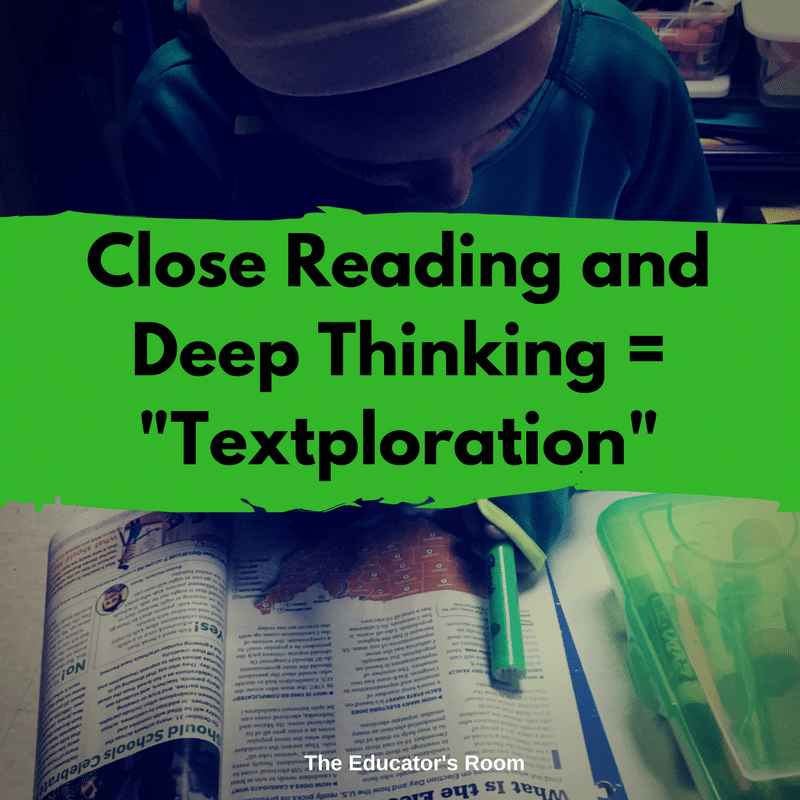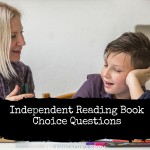My focus in this piece will be on inspiring truly close reading and deeper thinking as a facet of ELA instruction. When a reader can go beyond recall; go beyond simple inference and analysis, and go spelunking deep into reflection on and evaluation of story characters and elements (while using the text to support their thinking)…then we are talking about real reading! Better than simply reading and re-reading for facts in order to regurgitate accurate answers to text-based questions, great readers are built through motivating great thinking about what is read. I wrote recently about encouraging children to read and write, with a focus more on my own children and what goes on in my family, and I will describe that a little more, but I want to get into practice-how to make it happen in the classroom with kids that aren’t your own.
Encouraging children to read more includes getting them to see the reward in exploring stories, and showing them that they have the power to discover the depths-“cutting their teeth” so to speak with texts like The Tawny Scrawny Lion, then moving on to more school-aged reading like Mama Provi and the Pot of Rice, and then eventually more mature and developed stores like The Flying Machine, all three of which are examples of excellent reads that allow for deeper textploration (a combo of “text” and “exploration”).
The inclination to interact with stories like this isn’t something that just happens by accident. For myself: by the age of ten I had devoured all my Encyclopedia Brown and Hardy Boys sets, had a waist-high stack of overly-read comics, “Mad” and “Cracked” magazines, and so began on my mom’s bookshelf. 79 Park Avenue (Harold Robbins) was maybe not appropriate at that age, but Salem’s Lot got me hooked on King and then Bradbury didn’t come far behind (King is often a more immediate and visceral punch in the gut, Bradbury could gently weave a world and then gently blow your mind while you were all relaxed in it). My three daughters (and any reader) deserve those experiences more than to be simply trained through “grit and rigor” to test well and meet someone else’s standards. For my three daughters I have had to make sure to do that for them at home-and they are insatiable readers and writers. My number one struggled with dyslexia and entered 2nd grade as almost a non-reader (who still loved to tell, write and illustrate her own stories) but left reading at a fifth grade level and then too high to be accurately scored by 6th grade. She has won state and national-level Scholastic Awards recognition for her writing, and is entered again this (her senior) year. My middle girl is similar (but entered kindergarten reading at a 2nd grade level); my 10 year old not much different though she tends to get more political in her writing and penned a letter of gentle reprimand to candidate Trump last April regarding his behavior.
[bctt tweet=” interacting with stories isn’t something that just happens by accident. ” username=”EducatorsRoom”]
They think about the world. They think about others. They write, and when they read-they think about what they’re reading. Textploration- My kids do it because I do it and have modeled that for them. Now they no longer need me to show them how and I have conversations with my school-aged kids that would normally be heard at book club gatherings. I want young learners to experience and have that power, and for teachers to believe they have it –if they don’t already know it. But it needs to be trained. Sometimes even adults need to experience it explicitly because they actually do it without thinking about how their minds do it. You know-when you hit a punch-in-the-gut moment in a story and you have to sit back and go to that day-dreamy place where you reflect on the things that have happened so far in this fictional world that either informed or led to this moment; the other things that happened that might have led to other outcomes…sometimes you even find yourself turning back to reread for those moments. Some people call this “getting lost in a story”, I call it discovering the story. It’s the difference between a dead spelunker and one who returns from the depths with treasure. Textploration. It’s likely there are those reading this that know what I’m saying, and it’s often those powerful moments that keep me from getting those old powerful reads out of my basement and closets. Those stories are old friends and we have shared powerful memories, and I came out of them with treasure.
So how can we inspire young readers to want to read-to make powerful connections that keep them reading like that? The three stories I mentioned serve as a great sequence from early reader to young adult-adult examples, but there are so many more. Sometimes, when reading with students, new possibilities and new stories reveal themselves as adaptable to an approach like this. Not every book/story is well suited-some are simply skill-builders, but take a look at how these three stories might be used. For Mama Provi… I was unable to find an online link to the actual story, but it is worth adding to your classroom if you don’t have it.
Well suited for:
Basic questioning, straight from text stuff:
- typical baby-on-my lap learning about words, days of the week, animals…
- pre-school-primary grades sequencing of those things/events and getting into character actions/motivations (Why did the other animals stand “at a distance” to talk things over with the lion? When the animals told the fat little rabbit he was lucky and appointed him to talk with the lion, what were they trying to do?)
Deeper questions regarding character development/motivation:
- Were the characters different at the end of the story? Which characters changed the most/the least? Find evidence in the text to support your claim.
- Why do the big animals grin slyly when they “appoint” the fat little rabbit to talk to the lion?
- Even though carrot stew sounds awful to the lion, why does he still go with the rabbit to have supper at his house?
With my third and fourth graders, we basically speed through the early stages of getting into the story, because it’s a very easy read for them (text decoding-wise). We focus on reading fluency, story event sequencing, (the lion eats monkeys on Mondays, kangaroos on Tuesday, zebras on Wednesday…) noting author’s choice of mixing animals that don’t really exist in the same ecosystem and some humor to make the story more enjoyable, and then we ease into more serious thinking/discussion. In the end, the question is:
What caused such a remarkable change in the lion?
The structure of the story and the way it ends leads almost every child, older students…maybe even some adults to say “carrot stew”.
But that isn’t really a “deep dive”, it’s more a reflexive answer. In going back to the text, though, you see that even after getting his fill of that stew, the lion still wants to hang around long enough to get hungry again and eat those fine fat little rabbits. He hasn’t changed…he’s just temporarily full! But he stays, sings some songs with the rabbits late into the night, and goes home happy and whistling to himself.
He still doesn’t eat them!
So what is it really? The story doesn’t say but continues with the lion no longer wanting monkeys on Monday, Kangaroos on Tuesday… The kids have come up with ideas from the fact that he doesn’t have to run, run for his food (so he needs less) to the suggestion that the power of true friendship changed the way he felt about others. Up until meeting the rabbits, animals had always run away, stood at a distance, and had suspicious motives.
Even the lion himself, until the moment those fat rabbits unassumingly welcomed him, hopped onto his lap and sang songs with him, had nefarious rabbit-eating schemes in his heart.
To me, this is a great “dip your toes into the water” experience for older students and adults to think about what can be found in a great story and what kinds of questions can either be asked or discovered together in a group.
2) Mama Provi and the Pot of Rice
An old woman in an apartment building, on the first floor (many floors below her sick granddaughter), makes a great big pot of her rice and chicken (her granddaughter’s favorite) to bring to the girl. But Mama Provi “never, ever takes the elevator”, so she takes the stairs. Along the way, she must stop and rest and gets drawn by familiar wonderful smells to the doors of others in the building and into trades of her arroz con pollo for fresh baked bread, then on the next floor-black beans, then salad, greens, tea, apple pie… She starts in her first floor apartment and ends up at her granddaughter’s with a feast including her arroz con pollo and a little of all the other tasties she swapped for along the way.
Well suited for some of the simpler sequencing/character questions as warm-ups, similar to Tawny-Scrawny, but then there is more serious thinking to do. In the story she goes directly to, and knows exactly which door to knock on when she smells those wonderful smells. On another floor, a tenant has gotten a call from a previous “trader” and is waiting on the landing for Mama to make a trade herself. It seems these people all know of each other, are familiar with each other’s cooking skills and special dishes, and are more than happy to share/swap.
The story explains early on that Mama Provi doesn’t know how to cook for only two by referring to Mama’s past, but it’s interesting that she would “never ever” use the elevator and would instead lug that huge pot up 8 flights of stairs. She has to stop and rest a few times.
So why does she “never ever” take the elevator?
The story never explains. There is really no right or wrong answer. But there is some conclusions/responses that could be drawn from the text. Might this collective food economy be one that benefits Mama and other tenants in this building? Would taking the elevator negatively impact this community? As I discuss these thoughts with 3rd or 4th graders it’s great to see their wheels turning.
Which is more important to moving the plot in this story- the arroz con pollo or the stairs in the apartment building?
When a reader starts to think about character/plot/story/theme in this way, they go beyond just reading to survive academic assessments-they engage in the kind of thinking and discussion that makes their ability to reason extend beyond the confines of assessments.
The third reading I’m using as an example is one you should just read first without my description or questions. You may just come up with some of your own that you would use to guide discussion. A link to my thoughts and questions is at the very bottom.
One of my favorite Bradbury “shorts”. First read, ask yourself what questions you would try to resolve with other readers/learners.
Then, my thoughts and questions are here:
https://realedreform.com/2017/01/15/questions-to-accompany-the-flying-machine/







